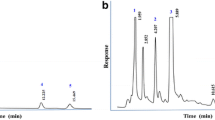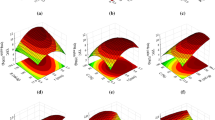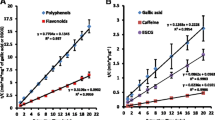Abstract
This work describes the simultaneous determination of catechins and caffeine in green, black tealeaves and canned tea-drink using micellar electrokinetic chromatography. The catechins analyzed include (+)-catechin, (-)-epicatechin, (-)-epigallocatechin, (-)-epicatechin gallate and (-)-epigallocatechin gallate. Using UV absorption method at 280 nm, the limits of detections of catechins and caffeine are 10−6 mol/L, which is suitable for the real sample determination. Using this analytical method, the extraction of these compounds from the tealeaves with hot water is compared under different temperatures. The effects of temperature on the amount of catechins and caffeine extracted are evident, showing that (-)-epigallocatechin gallate is the most easiest to be extracted at 100°C. The stability of catechins and caffeine in stocking solution of tea-drink at 4°C is also compared on five consecutive days. The contents of catechins and caffeine in green and black teas are discussed and the difference of the content between different tealeaves can provide a reference for the assessment of tea quality.
Similar content being viewed by others
References
Jankun, J., Selman, S. H., Swiercz, R., Why drinking green tea could prevent cancer, Nature, 1997, 387(5): 561–563.
Dalluge, J. J., Nelson, B. C., Determination of tea catechins, J. Chromatogr. A, 2000, 881(1–2): 411–424.
Finger, A., Khur, S., Engelhardt, U. H., Chromatography of tea constituents, J. Chromatogr., 1992, 624: 293–315.
Wang, Z. Y., Chang, S. J., Zhou, Z. C., Antimutagenic activity of green tea polyphenols, Mutat. Res., 1989, 223: 273–285.
Vinson, J. A., Dabbagh, Y. A., Serry, M. M. et al., Plant flavonoids, especially tea flavonols, are powerful antioxidants using an in vitro oxidation model for heart disease, J. Agric. Food Chem., 1995, 43(11): 2800–2802.
Lin, Y. L., Juan, I. M., Chen, Y. L. et al., Composition of polyphenols in fresh tea leaves and associations of their oxygen-radicalabsorbing capacity with antiproliferative actions in fibroblast cells, J. Agric. Food Chem., 1996, 44(6): 1387–1394.
Zhao, B. L., The anti-oxidant activity of catechins, Chin. Sci. Bull. (in Chinese), 2002, 47(16): 1206–1210.
Fernández, P. L., Pablos, F., Martín, M. J. et al., Study of catechin and xanthine tea profiles as geographical tracers, J. Agric. Food Chem., 2002, 50(7): 1833–1839.
Pierce, A. R., Graham, H. N., Glassner, S. et al., Analysis of tea flavanols by gas chromatography of their trimethylsilyl derivatives, Anal. Chem., 1969, 41(2): 298–302.
Collier, P. D., Mallows, R., The estimation of flavanols in tea by gas chromatography of their trimethylsilyl derivatives, J. Chromatogr, 1971, 57: 29–45.
Goto, T., Yoshida, Y., Kiso, M. et al., Simultaneous analysis of individual catechins and caffeine in green tea, J. Chromatogr. A, 1996, 749(1–2): 295–299.
Maiani, G., Serafini, M., Salucci, M. et al., Applicaion of a new high-performance liquid Chromatographic method for measuring selected polyphenols in human plasma, J. Chromatagr. B, 1997, 692(2): 311–317.
Wang, H. F., Provan, G. J., Helliwell, K., HPLC determination of catechins in tea leaves and tea extracts using relative response factors, Food Chemistry, 2003, 81(2): 307–312.
Khokhar, S., Magnusdottir, S. G. M., Total phenol, catechin, and caffeine contents of teas commonly consumed in the United Kingdom, J. Agric. Food Chem., 2002, 50(3): 565–570.
Arce, L., Ríos, A., Valcárcel, M., Determination of anti-carcinogenic polyphenols present in green tea using capillary electrophoresis coupled to a flow injection system, J. Chromatogr. A, 1998, 827(1): 113–120.
Li, Y., Gao, J. T., Zhang, Z. L. et al., Determination of catechins in grape seeds by capillary electrophoresis, Chinese Journal of Chromatography (in Chinese), 2000, 18(6): 491–494.
Barroso, M. B., Werken, G. V. D., Determination of green and black tea composition by capillary electrophoresis, J. High Resol. Chromatogr, 1999, 22(4): 225–230.
Larger, P. J., Jones, A. D., Dacombe, C., Separation of tea polyphenols using micellar electrokinetic chromatography with diode array detection, J. Chromatogr. A, 1998, 799(1–2): 309–320.
Horie, H., Kohata, K., Application of capillary electrophoresis to tea quality estimation, J. Chromatogr. A, 1998, 802(1): 219–223.
Nelson, B. C., Thomas, J. B., Wise, S. A. et al., The separation of green tea catechins by micellar electrokinetic chromatography, J. Microcolumn separations, 1998, 10(8): 671–679.
WÖrth, C. C. T., Wieβler, M., Schmitz, O. J., Analysis of catechins and cafeine in tea extracts by micellar electrokinetic chromatography, Electrophoresis, 2000, 21(17): 3634–3638.
Watanabe, T., Nishiyama, R., Yamamoto, A. et al., Simultaneous analysis of individual catechins, caffeine, and ascorbic acid in commercial canned green and black teas by micellar electrokinetic chromatography, Anal. Sci., 1998, 14(2): 435–438.
Pomponio, R., Gotti, R., Santagati, N. A. et al., Analysis of catechins in extracts of Cistus species by microemulsion electrokinetic chromatography, J. Chromatogr. A, 2003, 990(1–2): 215–223.
Pomponio, R., Gotti, R., Luppi, B. et al., Microemulsion electrokinetic chromatography for the analysis of green tea catechins: Effect of the cosurfactant on the separation selectivity, Electrophoresis, 2003, 24(10): 1658–1667.
Horie, H., Mukai, T., Kohata, K., Simultaneous determination of qualitatively important components in green tea infusions using capillary electrophoresis, J. Chromatogr. A, 1997, 758(2): 332–335.
Chen, C. C., Shi, L. L., Chen, C. C., Effect of extraction temperature and time on polyphenol contents and composition and sensory quality of oolong tea infusion, Food Sci., 1996, 23: 285–298.
Stach, D., Schmitz, O. J., Decrease in concentration of free catechins in tea over time determined by micellar electrokinetic chromatography, J. Chromatogr. A, 2001, 924(1–2): 519–522.
Lin, J. K., Lin, Y. L., Liang, Y. C. et al., Survey of catechins, gallic acid, and methylxanthines in green, oolong, pu-erh, and black teas, J. Agric. Food Chem. 1998, 46(9): 3635–3642.
Author information
Authors and Affiliations
Corresponding author
About this article
Cite this article
Song, G., Lin, J., Qu, F. et al. Extraction of catechins and caffeine from different tealeaves and comparison with micellar electrokinetic chromatography. Chin.Sci.Bull. 48, 2438–2443 (2003). https://doi.org/10.1360/03wb0105
Received:
Accepted:
Issue Date:
DOI: https://doi.org/10.1360/03wb0105




